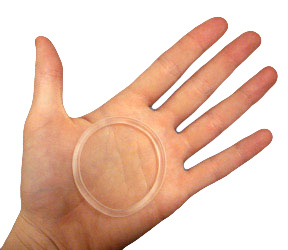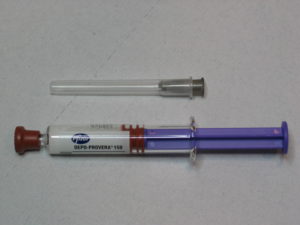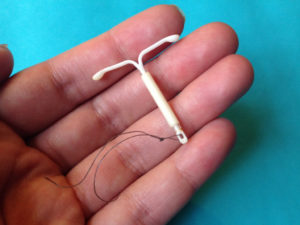Modern Birth Control Options
It’s 2018 ladies. Time to catch up on all sorts of modern birth control options. No longer do we have just a pill to settle for, we have a wealth of options. Lucky for you, I have a sister who is an OBGYN and helped me make this handy dandy chart to peruse. However, please always speak to your own doctor before deciding the best option for yourself.
Please note this list does not include basics like condoms, or spermicides nor does it include info on vasectomies or getting your tubes tied. Also note that when breastfeeding, the only safe types of birth control are progesterone or non-hormonal options.
Options
Type: Vaginal hormonal contraception (NuvaRing) 
How it works: This is an estrogen and progesterone hormone containing device that inhibits ovulation, which means your ovary does not release the egg. It also thickens the cervical mucus so sperm cannot reach the egg (in case an egg somehow does get released), and thins the lining of the uterus.
Benefits besides the obvious: A benefit of thinner uterine lining may mean less bleeding during your period.
How long it stays in: You wear it for 3 weeks, and remove it in the 4th week (this is when you have your period). You then insert a new ring at the completion of the 4th week. So 3 weeks on, one week off.
Effectiveness: 98% effective with correct typical use, down to 91% in real life (meaning, most people aren’t perfect and might not use it 100% correctly every time).
Any pain associated: Typically no. A majority of people do not feel it when it is in. You do have to be comfortable inserting and removing yourself.
Random info: People generally like it because you do not have to do something everyday. It can also stay in during intercourse. Once removed can have a quick return to fertility. It is however, not recommended to use if you are 35 or older AND a smoker (you’re ok if you are 35 or older and not a smoker), have a history of blood clot/stroke/heart attack, or have uncontrolled blood pressure.
Type: Patch 
How it works: The patch can be placed on your belly, upper arm, butt, or back. It has estrogen and progesterone hormones that prevent ovulation and thicken cervical mucus.
How long it stays on: One new patch a week for 3 weeks, then no patch for the 4th week (this is when you have your period).
Effectiveness: With perfect use 99% effective (changing the patch on time, that means to the minute every week), but it is generally 91% effective since most people aren’t perfect.
Any pain associated: No, it just sticks on your skin.
Random info: People like it because it is not daily. It can take a few months to return to fertility after use. It is not recommended to use if you are 35 or older AND a smoker, have a history of blood clot/stroke/heart attack, or uncontrolled blood pressure.
Type: Shot (Depo-Provera) 
How it works: You get a shot every 3 months at your doctors office. It has a progesterone hormone which prevents ovulation and thickens the cervical mucus.
How long it stays in your system: Once you get the shot, you don’t have to get another shot for three months.
Effectiveness: 99% effective if injections are done on schedule. Effectiveness decreases if injections are not on time (can be as low as 94% effective if not on schedule).
Any pain associated: Only the normal pain at site that is associated with getting any type of shot.
Random info: This is obviously not the best option for people who are afraid of getting shots. Some people like it because you only need 4 injections a year, so it’s not something that is on your mind every day or every week. After being on it for about a year some people stop getting their period. It can take approximately up to 10 months to resume fertility after stopping it. If a person is not a candidate for using estrogen (mostly due to health reasons) in their contraception, this is a good alternative. It can lead to bone loss, but once you stop taking the shot, the bone loss resolves.
Type: Pill, two types: 
- Combined contraception (estrogen and progesterone pills), or
- Progesterone only pills.
How it works: You take a pill each day and the pill prevents ovulation and thickens cervical mucus. Progesterone only pills do not prevent ovulation as consistently.
How long you have to take it: Every day at the same time.
Benefits besides the obvious: Combined pills can improve acne or painful periods.
Effectiveness: 99% effective with perfect use but in real life can be as low as 91%-95%
Any pain associated: When first starting pills you can have sore breasts, spotting or bleeding between periods (which can happen with any method). You can also get headaches, but these usually go away by 3 months.
Random info: It’s not uncommon to stop having your period with newer monophasic pills (pills that have the same dose of hormones in each pill in the pack as opposed to triphasic pills which is where the doses of hormones in the pill changes every week in a pack). It is not recommended to use combined contraception if you are 35 or older AND a smoker, have a history of blood clot/stroke/heart attack, uncontrolled blood pressure or super severe migraines. You can use progesterone pills if you are a smoker.
Type: LARCs (Long Acting Reversible Contraception), three types: 
- Progesterone Intrauterine device (IUD) (several brand names Mirena, Kyleena, Skyla, and Liletta)- the differences between these are the amount of progesterone in the IUD and how long it can stay in.
- Copper IUD ( Brand name: Paragard, non-hormonal)
- Nexplanon (Progesterone implant)
How each works:
- Progesterone IUD: The doctor inserts one into the uterus. It thins the lining of the uterus and thickens the cervical mucus.
- Copper IUD: The doctor inserts one into the uterus. The copper interferes with sperm movement and fertilization.
- Nexplanon: The doctor inserts one into the inner part of your upper arm. It prevents ovulation and prevents sperm from reaching egg if ovulation occurs.
All would need to be removed by a doctor.
How long it stays in:
- Mirena 5 years, Kyleena 5 years, Skyla 3 years, Liletta 4 years
- Copper IUD Paragard 10 years
- Nexplanon 3 years
Benefits besides the obvious: You would not have to worry about getting pregnant for loooooong periods of time and you don’t have to remember anything.
Effectiveness: All are 99% effective
Any pain associated: Can have some discomfort at time of insertion and removal for all. For the IUDs, may also have some cramping after insertion.
Random info: The progesterone IUDs will regulate your period after maybe a small period of time with irregular periods. Sometimes periods will go away with the progesterone IUDs (more common with higher doses), but you are more likely to have shorter and lighter periods over all. Paragard is non-hormonal and may make periods heavier and longer with worse cramps. A common reason to discontinue nexplanon is an unfavorable change in bleeding patterns (longer bleeding, shorter bleeding, spotting).











